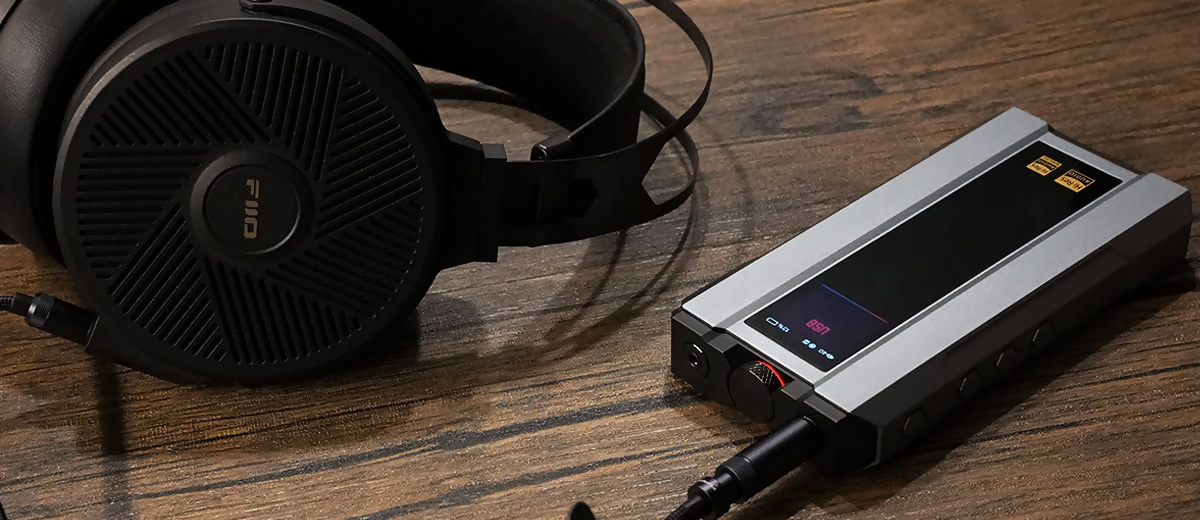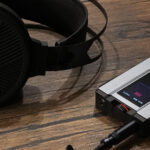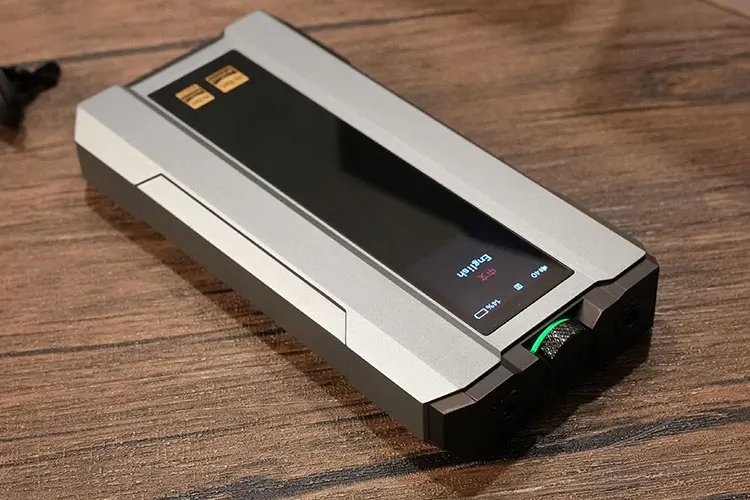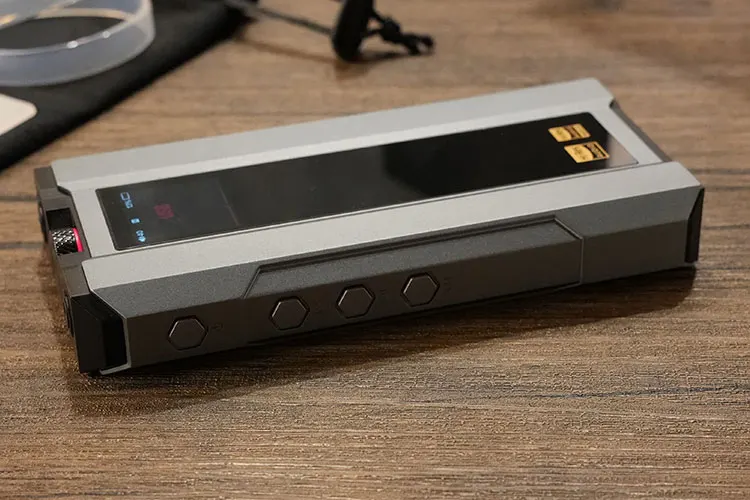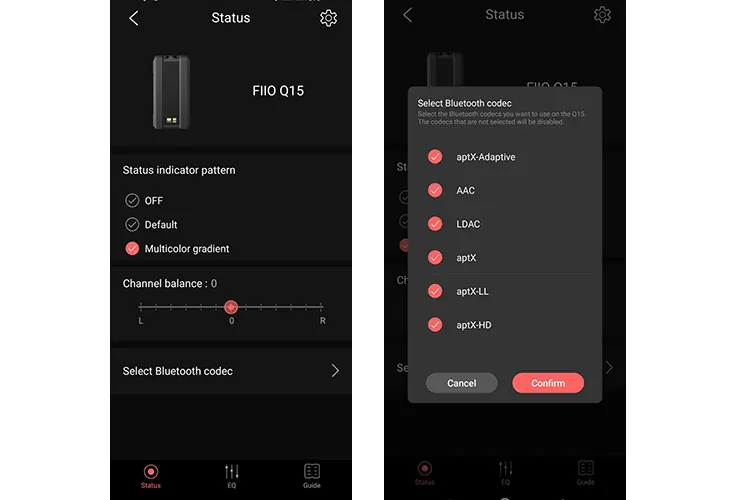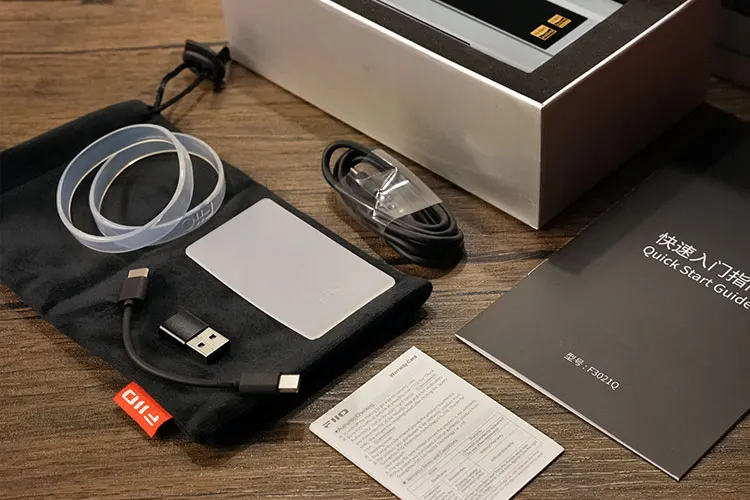We review the FiiO Q15, which is a Bluetooth-equipped portable DAC and headphone amplifier with up to 1.6W of output power in desktop mode. It is priced at $399.99.
Disclaimer: This was sent to us as a sample in exchange for our honest opinion. Headfonics is an independent website with no affiliate links or services. We thank FiiO for its support.
You can click here to learn more about the FiiO audio products we have previously assessed on Headfonics.
Note, that this post follows our current scoring guidelines which you can read in more detail here.
Towards the end of 2023, FiiO further expanded its new portable DAC and headphone amplifier series with the new Q15 which is priced at $399.
The Q15 sits just below the previously reviewed flagship Q7 and ahead of the smaller Q3 and the Q11 models.
Perhaps you could consider this as a baby Q7 though as it has similar design traits and some shared features of the bigger sibling for almost half the price.
Tech Highlights
The FiiO Q15 is primarily a battery-operated portable DAC and headphone amplifier with additional Bluetooth wireless capability and a desktop mode that allows you to maximize its power output for harder-to-drive headphones.
DAC
The Q15 is the first portable decoder and headphone amp in FiiO’s lineup to incorporate the AKM AK4499EX DAC.
These flagship DAC chips employ a complete separation of the digital and analog circuitry, accompanied by the AK4191EQ, resulting in significantly improved technical performance compared to their more integrated predecessors. The DAC supports native DSD 512 decoding and PCM up to 192kHz/24bit.
The Q15 is also equipped with a Qualcomm QCC5125 chipset allowing for wireless decoding at up to LDAC 24Bit/96kHz and aptX Adaptive.
Amplification
The Q15 can deliver a maximum output of 1600mW per channel on the balanced output when utilizing the USB-powered Desktop Mode.
This mode effectively transforms the Q15 into a desktop DAC and amplifier. By relying solely on the external USB power source, the device does not drain its internal battery, and users can benefit from a more robust output while ensuring the longevity of the device’s battery.
For pure portable amplification, the numbers drop to 1060mW into a 32Ω load balanced and for single-ended on a similar load you get a maximum of 400mW.
On a side note, when running on battery power, the playback time is roughly 8 hours on SE output and 9 hours on BAL output.
Design
The Q15 has a visually striking design characterized by a highly masculine and intricately layered aesthetic. It is available in two color options: black and titanium.
The titanium variant, in particular, exudes a techy vibe with its contrasting shades of grey and black, which adorn its faceted body. This color scheme adds to its contemporary and futuristic appeal.
A notable feature of the design is the vibrant RGB indicator that encircles the volume knob. This enhances the overall color scheme and adds a touch of premium appeal to the device.
The body design of the Q15 draws inspiration from its bulkier flagship counterpart, the Q7 while being significantly more portable at 305g. Despite its smaller size, the Q15 manages to retain the design essence of the Q7, resulting in a sleek and premium appearance.
FiiO has made notable improvements in the design of the Q15, incorporating more colors, contrast, and detailing.
One example is the use of matte glass at the back, adding a touch of elegance and sophistication. The inclusion of colored USB-C ports further enhances the visual appeal and adds a stylish element to the device.
Great attention to detail can be seen in the effort put into making the screws less visible, creating a cleaner and more polished aesthetic. This contributes to a more refined overall appearance, giving the Q15 a premium and well-crafted feel.
Display
The front side of the Q15 features an embedded IPS panel, which displays the current sampling rate, volume, gain setting, and battery level.
By pressing the button and turning the knob, users can easily navigate through different options and settings available on the display. There is no need to read the user manual and you can navigate through all options with ease.
I/O
The Q15 is equipped with 4.4mm BAL and 3.5mm PO outputs. In terms of digital connections, it supports Coaxial input and USB-C input, allowing users to connect devices such as Bluetooth receivers or CD transports and listen to the audio through the headphone outputs.
Additionally, there are two USB ports on the Q15, with one dedicated to PD fast chargers. When connected to a PD fast charger, the Q15 enters Desktop Mode, providing enhanced power and performance.
Controls
The volume knob on top of the Q15 is multi-functional, allowing for easy menu navigation by turning and pressing it. Single-hand operation is possible, aided by the presence of playback control buttons on the sides, which simplifies the use of the Q15 as a USB decoder.
To activate the Desktop Mode, you can simply use PD chargers from phones or laptop purchases and plug them into the orange-colored port on the back of the Q15, then switch to Desktop Mode in the control menu.
I tried using my MacBook Air M2 45W Charger, my iPad Pro 18W charger as well as my Xiaomi 65W charger and all of it works without any issues.
In addition to the Desktop Mode, the Q15 also features a Phone Mode. When Phone Mode is enabled, the Q15 will not draw power from the connected phone.
Instead, it will rely on its built-in battery for power supply. This can be particularly useful for situations where charging the phone is not feasible throughout the day, ensuring that the phone’s battery is conserved while enjoying listening.
The layout is intuitive, facilitating effortless navigation through various options. Alternatively, adjustments can be made conveniently using the control application.
FiiO Control App
Similar to other FiiO devices we have discussed, the Q15 supports app control. Through the control application, users can adjust various settings such as the PMEQ (Parametric Equalizer) and other behaviors of the device.
The Q15 offers support for 10-band EQ adjustments through its control app. This EQ feature applies to all Bluetooth codecs and USB-DAC inputs. Also, there are 7 preset EQ settings, which are handy for adjusting the audio output based on different usage scenarios or music genres.
Additionally, the Q15 provides 3 user-customizable PEQ (Parametric Equalizer) slots. These slots enable users to create and save their own personalized EQ settings for quick adjustments.
Packaging & Accessories
The Q15 comes with a variety of accessories to enhance the user experience. These accessories include a carrying pouch, USB-C to USB-C connectors in both long and short lengths, a USB-C to USB-A converter, silicone bands, a silicone pad, and user manuals.
The USB-C to USB-C connectors and USB-C to USB-A converter offer flexibility in connecting the device to different sources and equipment.
The silicone bands are useful for securing the Q15 to other devices while the silicone pad serves as a protective layer when stacking the Q15 beneath your player or phones, preventing scratches or damage to either device.
Sound Impressions
These impressions are based on using the Westone MACH 30, Earsonics Elements, final A8000, MOONDROP PARA, and FiiO’s FT5.
Summary
Despite being advertised as very powerful, the Q15 delivers well-controlled sound with plenty of texture and fine details. It also exhibits a slight emphasis on the treble side.
When used with sensitive IEMs on lower gain settings, it produces a dynamic and layered sound without noticeable background noise.
Even at very high volumes, the Q15 maintains excellent resolution and noise control, surpassing the performance of some traditional desktop decoders and amplifiers in terms of definition.
When connected via USB, the Q15’s sound is denser and slightly fuller in the mid-lows, while also exhibiting effortless extension in the treble. This makes it a recommended choice for pairing with a DAP or phone to achieve the best output quality.
Switching to Desktop Mode results in a noticeably clearer output with enhanced transparency, particularly noticeable when using headphones.
The Q15 provides sufficient power to drive IEMs even in non-PD-powered settings. Both modes maintain a good balance, with the tuning emphasizing vocal penetration power.
Bass
The Q15 exhibits meticulous balance in the lower frequencies, ensuring sufficient presence for bass instruments without pushing them too far forward and maintaining an overall clean signature.
The low end provides ample power and extension, accompanied by a moderately fast response speed that enables clear capturing of the resonance of chamber sounds, while still maintaining a controlled and defined presentation.
At low gain, the bass is rendered neutrally, while at higher gain settings, it becomes firmer and bolder.
This allows for the detection of subtle details in the sub-bass region and creates a rich and dense bass experience with clearly heard transients. The fundamental frequencies of vocals are also well-weighted, resulting in clear imaging and definition of voices.
Mids
The mids on the Q15 exhibit swift articulation, resulting in a clear and fast-paced presentation of the vocal line. The emphasis on the vocal body is well-balanced, contributing to an overall even output.
The clean sound signature of the Q15 is particularly suited for fast-paced electronic music and pop genres, as well as synthesized instruments.
While the tuning sounds quite smooth, the Q15 also displays good density across the midrange, especially with IEMs like the A8000 which is very potent in delivering strong transients.
This is also reflected by a strong sense of positioning for instruments across the mids, with vocals offering sufficient body and bite.
Treble
There is good brilliance in the treble on the Q15, probably due to the high power, which adds some extra sparkle to the rather neutral tuning framework.
Woodwinds and string instruments sound clear and vivid. With a gentle roll-off, good openness and sparkle are retained, adding to the vividness of vocal and instrumental harmonics.
With IEMs that are revealing in the treble, or monitoring gears, you can hear good extension in the treble, yet linearly extended without sharp spikes.
Staging & Dynamics
The mid-low frequencies on the Q15 are energetic and dense sounding, as is the extension on both ends of the spectrum. This gives an impression of solid imaging for instruments and voices across the mids without pushing them too far forward.
The bass reproduction exhibits sufficient layering, allowing for discernment of different bass elements, while the vocal harmonics are well presented. The airiness in the treble also contributes to the overall vividness of the perceived stage.
The Q15 maintains a good sense of precision in instrument placement and imaging. The combination of adequate transparency, control, and adequate warmth in the mid-lows creates a harmonious balance within the entire frequency spectrum.
Click on page 2 below for our recommended pairings and selected comparisons.

